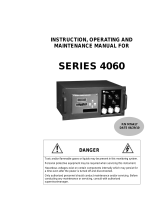Page is loading ...

Proteus Industries Inc.
200 Series F
low Switches
Installation and Operating Instructions
This document provides basic information describing the plumbing and electrical
connections, and trip point adjustments to install and make operational your 200 Series
Flow Switch.
A comprehensive Technical Reference Manual for these devices can be downloaded or
printed from www.proteusind.com/200/200SeriesTRM.pdf
.
This manual includes technical descriptions, performance specifications, and
dimensions, mounting instructions, detailed dimensional drawings, pressure drop
curves, maintenance instructions and part numbers for replacement parts.
If you are unable to access the Internet to obtain this manual, a printed copy can be
mailed to you. Please write, call or fax us with your request.
Section 1: Flow Ranges and Pipe Connections
Table 1 lists the model numbers and flow ranges. Model 200XX versions can be
configured in one of three different ranges, depending on the placement of the supplied
blanking plugs. Use of inlet fittings or pipes with small ID’s can alter the calibration
and flow rate readings. Please see the technical reference manual for details.
Flow Range
Brass
Celcon
Poly-
propylene
Stainless
Steel
Connection
Size FNPT
GPM LPM
¼” 0.06 – 0.6 0.2 – 1.9 0204Bxx 0204Lxx 0204Pxx 0204SSxx
¼” 0.1 – 1.0 0.4 – 4.0 0201Bxx 0201Cxx 0204Pxx 0204SSxx
¼” 0.5 – 2.5 1.9 – 9.5 0205Bxx 0205Cxx 0205Pxx 0205SSxx
¼” 0.8 – 6 3 - 27 0203Bxx 0205Cxx 0205Pxx 0205SSxx
½ 1.5 – 12 6 – 45 0250Bxx 0250Cxx 0205Pxx 0205SSxx
½ 4 – 20 15 – 75 0255Bxx 0255Cxx 0255Pxx 0255SSxx
¾ 6 – 30 22- 110 0260Bxx 0260Pxx 0260SSxx
1” 10 – 60 35 - 225 0270Bxx 0270Pxx 0270SSxx
Table 1: Flow Ranges and Pipe Connection
2.
Connect plumbing
• Do NOT exceed the pressure limit of the faceplate.
• Do NOT use SWAK®, Loctite® or other anaerobic pipe sealants with devices with a clear
plastic faceplate. Vapor from these materials cause the faceplate to crack!
• Do NOT install metal fittings into polypropylene or Celcon® units
• If temperature will exceed 85ºC the electronics should be isolated from the flow sensor.
1. Identify the type and size of connections from the Model Number Table above.
Do NOT exceed the flow limit of your flow sensor!
2. Use Teflon tape or paste to lubricate and seal NPT threads.
3. Turn on your liquid flow slowly and check for leaks at the connections. Tighten
connections as required to eliminate leaks.
Proteus Industries Inc.
340 Pioneer Way
Mountain View CA 94041-1577
Phone: (650) 964-4163 Fax: (650) 965-0304 email: [email protected]
xx = 12 VDC
or
xx = 24 VDC

3.
Make the electrical connections
Note
Only personnel familiar with the electrical circuit and control functions of the system in which
the sensors are to be included should perform installation of this product.
24V-DC and 12V-DC wiring Diagrams
Color
+12 VDC Input
0-5V analog output
+24 VDC Input
0-5V analog out
+24 VDC Input
4-20ma output
Red +12 VDC +24 VDC +24 VDC
Black Ground
Brown 0-5 VDC Out 0 to 20 mA out
White Ground
Orange +5 VDC out (to power an external display)
Green Relay-Normally Open
Blue Relay Common
4. Adjust trip point If a label on the back cover shows a factory-set trip point, no adjustment is needed.
1. Remove the yellow label on the back of the unit to access the trip point adjustment screw.
2. Install the flow switch in your actual circuit or calibration bench.
If a calibration bench is used ensure that the inlet fitting is of the same form as that used
in your actual circuit.
3. Adjust the actual flow rate to the minimum flow rate at which the trip point is to be set.
Ensure that all air is removed from the meter BEFORE adjusting the trip point.
4. Connect an ohmmeter between the blue and green wires.
5. With a small insulated screwdriver adjust the potentiometer until the ohmmeter shows that the
relay has changed state.
Turn the potentiometer clockwise to LOWER the trip point flow rate.
Turn the potentiometer counter-clockwise to RAISE the trip point flow rate.
6. The trip point is slightly different for rising and falling flow rates. It is recommended that the trip
point be set on a falling flow rate.
Document Number 620200 Rev 02 © Proteus Industries Inc. May, 2006
/












